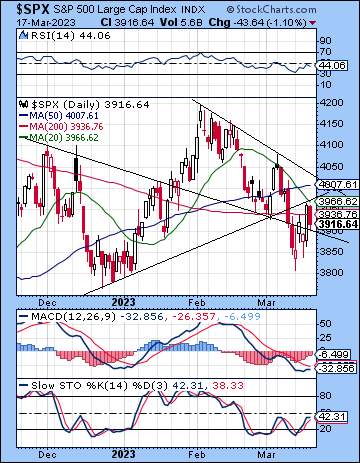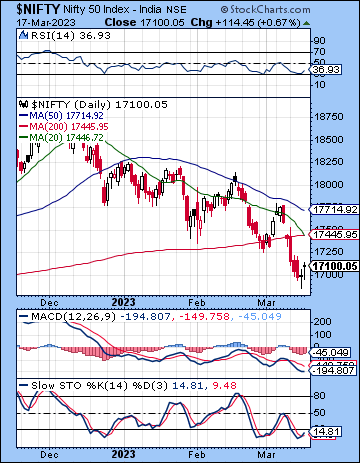 (19 March 2023) Stocks rebounded last week after the Fed intervened in the SVB banking crisis amid growing recession fears and sharply falling bond yields. The S&P 500 rose by more than 1% to 3916 while the rate-sensitive Nasdaq-100 surged almost 6% as investors went in search of safer havens. This bullish outcome was not wholly unexpected as I noted the contradictory mix of influences pointed towards a possible choppy week which had the potential to frustrate bears eager for more downside.
(19 March 2023) Stocks rebounded last week after the Fed intervened in the SVB banking crisis amid growing recession fears and sharply falling bond yields. The S&P 500 rose by more than 1% to 3916 while the rate-sensitive Nasdaq-100 surged almost 6% as investors went in search of safer havens. This bullish outcome was not wholly unexpected as I noted the contradictory mix of influences pointed towards a possible choppy week which had the potential to frustrate bears eager for more downside.
The narrative now seems to have well and truly shifted towards an impending recession. Last week’s bank bailouts have produced a collapse in bond yields as banks will tighten up their credit standards and reduce lending. And with the Credit Suisse now on the verge of insolvency, it is clear that rising interest rates have exposed possible contagion risk within the banking sector as a whole. Risky investments in long-dated bonds are not only reducing profitability, they now threaten to undermine many smaller and mid-sized banks. The consequent reduction in lending is likely to throttle economic growth in the short term, with ominous implications for the stock market.
 The banking crisis makes the Fed’s task more difficult this week as the FOMC meets to set its policy on Wednesday. Current odds still favor a 25 basis point hike, although there is now a 40% probability of a pause in rate hikes. The end of year terminal rate has now fallen to just 4% after being as high as 5.5% two weeks ago. Clearly, the financial terrain has shifted as the Fed will have no choice but to pause and pivot sooner than anticipated, data notwithstanding. Of course, with the Fed’s current funds rate now at 4.63% (soon to be 4.88% (?)), the Fed’s monetary policy is very tight as it is exceeds the 2-year Treasury at 3.81% by almost a full percent. As long as the Fed funds rate remains well above the 2-year yield, stock prices are likely to be under pressure. With its test of key support at 3.40% and the 200 DMA, the 10-year Treasury yield is signaling a possible recession ahead. Any break below this support level would suggest a shift towards a risk-off bias in the markets.
The banking crisis makes the Fed’s task more difficult this week as the FOMC meets to set its policy on Wednesday. Current odds still favor a 25 basis point hike, although there is now a 40% probability of a pause in rate hikes. The end of year terminal rate has now fallen to just 4% after being as high as 5.5% two weeks ago. Clearly, the financial terrain has shifted as the Fed will have no choice but to pause and pivot sooner than anticipated, data notwithstanding. Of course, with the Fed’s current funds rate now at 4.63% (soon to be 4.88% (?)), the Fed’s monetary policy is very tight as it is exceeds the 2-year Treasury at 3.81% by almost a full percent. As long as the Fed funds rate remains well above the 2-year yield, stock prices are likely to be under pressure. With its test of key support at 3.40% and the 200 DMA, the 10-year Treasury yield is signaling a possible recession ahead. Any break below this support level would suggest a shift towards a risk-off bias in the markets.
The planetary outlook is bearish. While we did see some evidence of the bullish Jupiter-Chiron and Jupiter-Uranus influence last week, it is unclear how much longer this may last. Jupiter makes another key alignment this week, but it is much less reliably bullish since it is with its bearish nemesis, Saturn. The 45-degree Jupiter-Saturn alignment is exact on Tuesday and Wednesday, just near the time of the FOMC meeting. As a rule, Jupiter-Saturn alignments are actually bearish…
Click here to subscribe and read the rest of this week’s newsletter
Photo Credit: felissy



